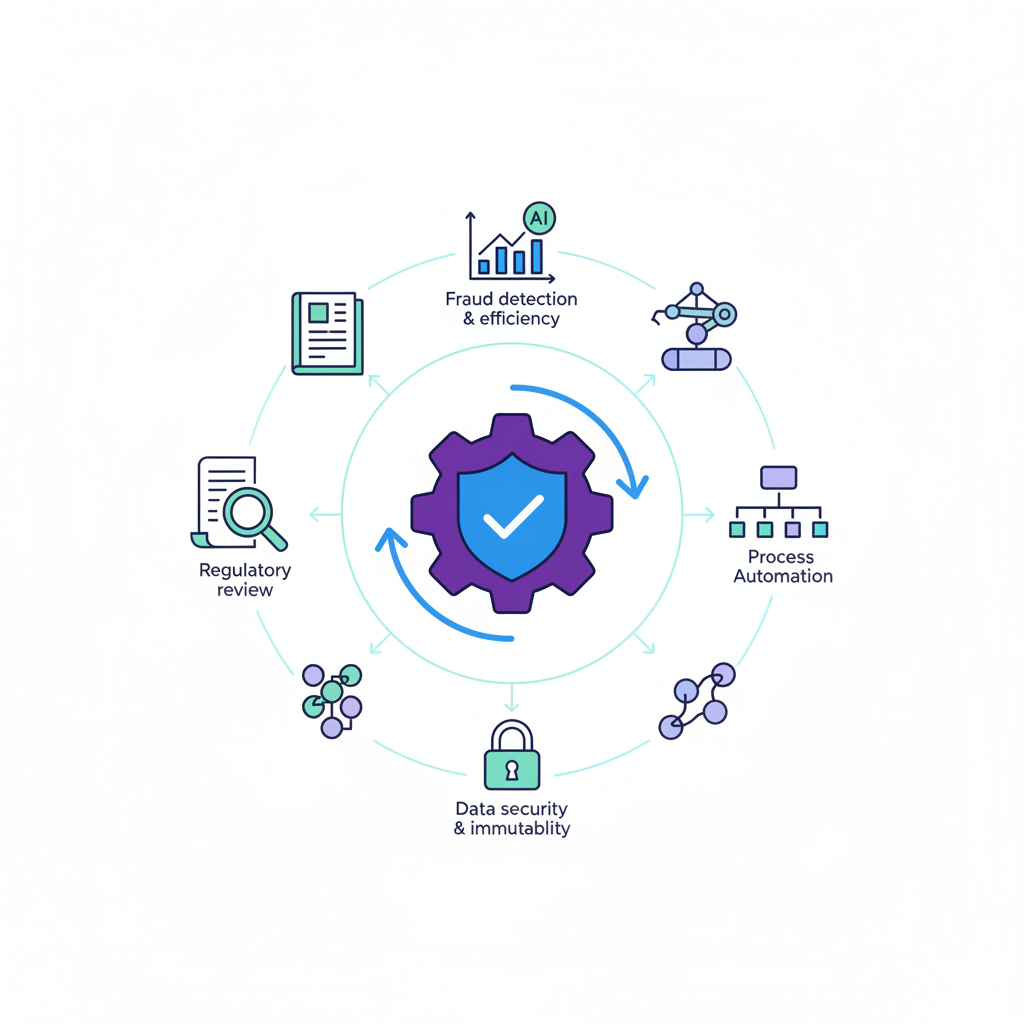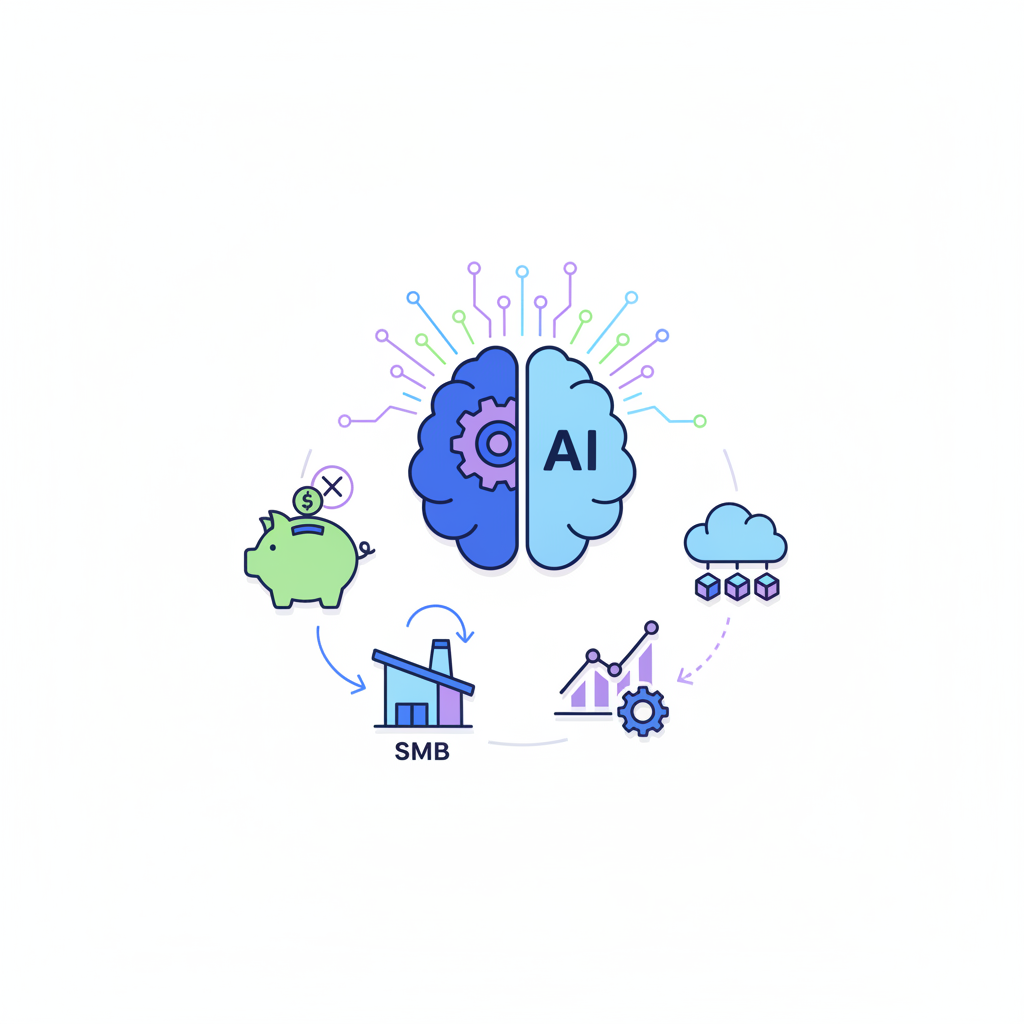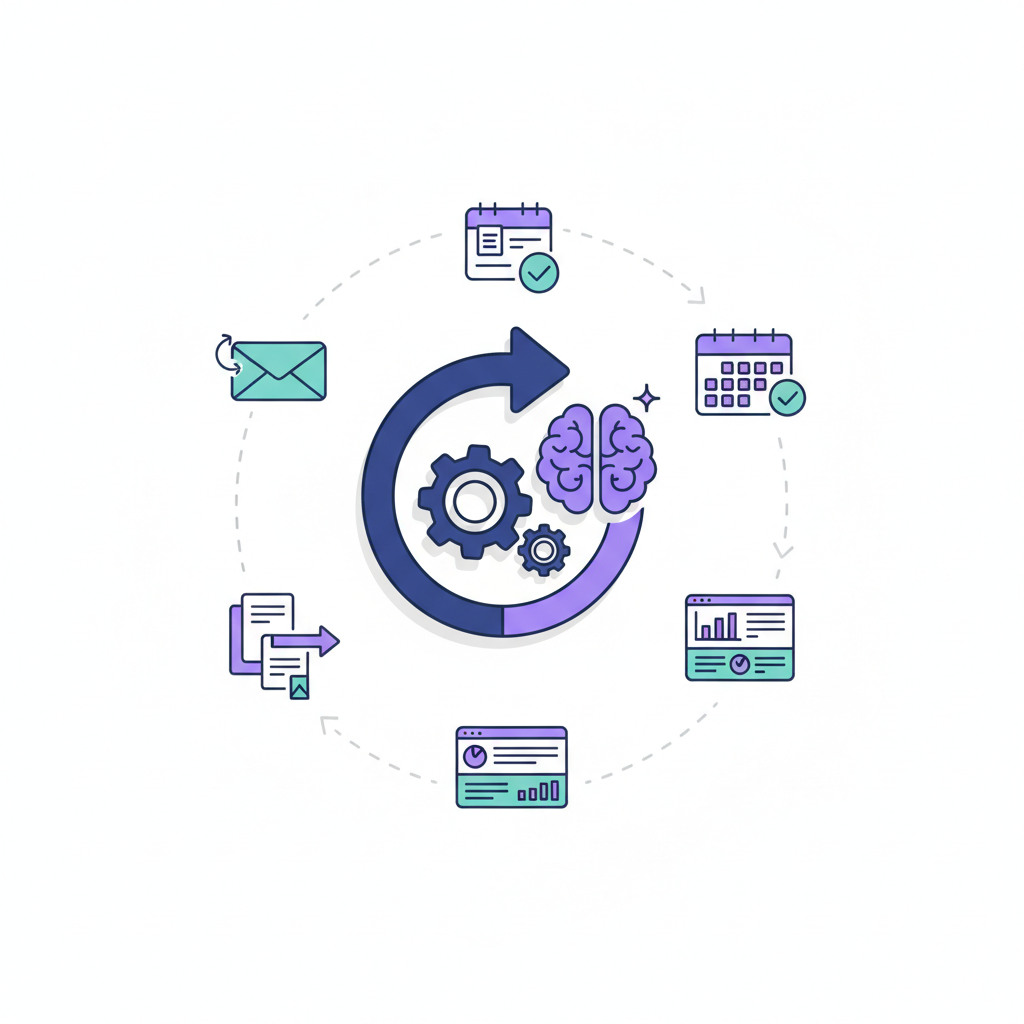How to build an AI-powered business workflow
A comprehensive, step-by-step guide to designing, implementing, and scaling AI-powered business workflows. Learn how to identify opportunities, select tools, ensure data readiness, and drive organisational efficiency with intelligent automation.

Unlocking Efficiency: Building AI-Powered Business Workflows
In today's hyper-competitive landscape, the accelerating pace of business demands not just efficiency, but also relentless innovation. Organizations are constantly seeking ways to streamline operations, reduce costs, and gain a decisive edge. Artificial intelligence (AI) stands at the forefront of this transformation, promising unprecedented levels of automation and insight. However, while many businesses recognize the immense potential of AI, particularly for workflow automation, they often struggle with the practical implementation. The journey from conceptual understanding to a fully functional AI-powered business workflow can seem daunting, fraught with technical complexities and strategic uncertainties.
This comprehensive guide is designed to demystify that process, offering a clear, actionable roadmap to successfully build and deploy an AI-powered business workflow. We will break down the entire lifecycle, from initial strategic planning and identifying high-impact opportunities to selecting the right AI workflow tools, meticulous implementation, continuous optimization, and critical business considerations like change management and ethical AI. By following the steps outlined here, readers will learn how to harness the power of artificial intelligence workflow to drive significant organizational efficiency, transforming their operations and positioning their business for future growth. Prepare to unlock a new era of productivity and strategic advantage.
1. What is an AI-Powered Business Workflow and Why Does it Matter?
An AI-powered business workflow represents a significant evolution from traditional automation. While conventional workflow automation typically relies on predefined rules and sequential logic to execute tasks, an AI workflow integrates artificial intelligence capabilities to perform tasks that require cognitive functions such as understanding, reasoning, learning, and decision-making. This means that instead of merely following instructions, an AI workflow can interpret unstructured data, adapt to new information, and make intelligent choices, often learning and improving over time. It’s about creating intelligent automation that can handle variability and complexity, moving beyond simple robotic process automation (RPA) to truly intelligent process automation.
The core components of AI workflow automation typically include: Data Input, where raw information (text, images, audio, structured data) is fed into the system; an AI Model, which is the brain of the operation, utilizing technologies like Natural Language Processing (NLP) for text understanding, Machine Learning (ML) for pattern recognition and prediction, or Computer Vision for image analysis; Decision Logic, which processes the AI model's output to determine the next steps; an Action Output, where the system performs a task (e.g., sending an email, updating a database, generating a report); and crucially, a Human-in-the-Loop component, allowing for human oversight, intervention, and validation, especially for complex or sensitive decisions.
The transformative benefits of AI workflow automation tools are profound. They lead to enhanced accuracy by minimizing human error, significantly increased speed in processing tasks, and substantial cost reduction through reduced manual labor. Furthermore, AI workflows offer unparalleled scalability, allowing businesses to handle fluctuating workloads without proportional increases in resources. They also enable improved decision-making by providing data-driven insights and freeing human talent from repetitive, mundane tasks, allowing them to focus on strategic initiatives, creativity, and complex problem-solving. This shift dramatically boosts organizational efficiency and allows businesses to streamline tasks with AI workflow.
So, how can I automate my business using AI? The broad impact spans across virtually every department. Consider common AI workflow use cases: In Customer Service, chatbots powered by NLP can handle routine inquiries, while sentiment analysis tools can gauge customer mood from interactions, routing urgent or negative feedback to human agents. In Finance, AI can automate invoice processing, reconcile accounts, and detect fraudulent transactions by identifying anomalies. HR departments can leverage AI for resume screening, quickly identifying qualified candidates based on specific criteria, and even personalizing employee onboarding. In Marketing, AI assists with content generation, personalizing email campaigns, and highly accurate lead scoring, predicting which prospects are most likely to convert. These examples merely scratch the surface of how artificial intelligence workflow can revolutionize operations, making it an indispensable tool for modern businesses seeking process automation and competitive advantage.
2. Phase 1: Strategic Planning & Data Readiness
The journey to building an effective AI-powered business workflow begins not with technology, but with meticulous strategic planning and a deep understanding of your existing operations. This foundational phase is critical for ensuring that your AI adoption efforts yield tangible ROI and align with overarching business objectives, ultimately enhancing organizational efficiency.
The first step involves identifying high-impact automation opportunities. This requires a thorough analysis of your current business workflow. Begin by mapping out key processes end-to-end, documenting each step, the data involved, and the human effort required. As you do this, pinpoint tasks that are repetitive, data-heavy, prone to human error, or bottlenecks in your current system. These are prime candidates for AI-driven automation. For instance, processes involving large volumes of document processing, data entry, customer inquiry handling, or routine decision-making are often excellent starting points. Look for areas where even small improvements in speed or accuracy can have a significant ripple effect across the organization.
Once potential opportunities are identified, a prioritization framework is essential. Not all automation opportunities are created equal. Assess each potential AI workflow based on its potential ROI (Return on Investment), its complexity of implementation, and its strategic alignment with your business goals. High ROI might come from significant cost savings, error reduction, or increased throughput. Complexity involves factors like data availability and quality, the need for specialized AI technologies, and integration challenges. Prioritize projects that offer a high ROI with manageable complexity, and those that directly support your strategic objectives, such as improving customer experience or accelerating product development.
Crucially, you must define clear objectives and success metrics before embarking on any AI initiative. Establish SMART (Specific, Measurable, Achievable, Relevant, Time-bound) goals for each AI-powered business workflow. What exactly do you aim to achieve? Is it a 30% reduction in processing time for invoices? A 15% decrease in customer service response times? A 10% improvement in lead conversion rates? These objectives should be quantifiable. Simultaneously, establish Key Performance Indicators (KPIs) for ROI measurement, such as cost savings, error reduction rates, throughput increases, or improved customer satisfaction scores. These metrics will be vital for evaluating the success of your AI workflow and demonstrating its value.
Data preparation and management strategy is arguably the most critical component of this phase. AI models are only as good as the data they are trained on. Conduct a comprehensive data audit to understand what data you have, where it resides, and its quality. This often involves significant data cleaning to remove inconsistencies, duplicates, and errors. Data labeling, where relevant features in your data are tagged for AI model training, is also a common requirement. You may also need data transformation to convert data into a format suitable for AI consumption. Practical advice includes establishing clear data collection protocols, ensuring data consistency across systems, and planning for ongoing data maintenance.
Finally, data governance cannot be overlooked. As you collect and process more data, especially with AI, considerations around data security and privacy become paramount. Implement robust data governance policies that comply with relevant regulations such as GDPR, CCPA, and industry-specific standards. This includes defining data ownership, access controls, retention policies, and ensuring ethical data usage. A strong data governance framework builds trust, mitigates risks, and lays a secure foundation for your AI-powered business workflow.
3. Phase 2: Designing Your AI Workflow & Tool Selection
With a solid strategic plan and a clear understanding of your data landscape, the next critical phase involves meticulously designing your AI workflow and selecting the appropriate AI workflow tools and platforms. This stage translates your strategic objectives into a tangible, executable plan.
The first step is detailed workflow design. This involves mapping out the end-to-end process of your AI-powered business workflow with granular precision. Utilize flowcharts or business process modeling notation (BPMN) to visually represent every step. Identify all data inputs and outputs, human touchpoints where human intervention or validation is required, and critical decision points where the AI model will provide insights or make choices. Clearly define the sequence of operations, conditional logic, and how different systems will interact. For instance, if automating customer support, map how an incoming query is received, processed by an NLP model, routed based on sentiment, and then either auto-responded to or escalated to a human agent, with all relevant data captured and updated in a CRM. This detailed mapping ensures clarity, identifies potential bottlenecks, and forms the blueprint for implementation.
Next comes choosing the right AI workflow tools and platforms. This is a pivotal decision, as the landscape of AI technologies and AI products is vast and constantly evolving. Your selection criteria should be comprehensive, considering factors such as the specific AI capabilities required (e.g., NLP, computer vision, predictive analytics), the complexity of your workflow, your budget, and your team's technical expertise.
We can broadly categorize AI workflow tools into three main types:
- No-code/Low-code AI Platforms: These platforms are ideal for businesses with limited in-house AI expertise or those looking for rapid deployment. Tools like Zapier, Microsoft Power Automate, UiPath, and Make (formerly Integromat) allow users to build sophisticated workflows by connecting various applications and services with pre-built AI components. They often feature drag-and-drop interfaces and pre-trained AI models for common tasks like text classification or image recognition.
- Specialized AI APIs/Services: For more specific or advanced AI capabilities, businesses can leverage cloud-based AI services and APIs from providers like OpenAI (for advanced language models), AWS Rekognition (for computer vision), Google Cloud AI Platform (for various ML services), or Azure AI Services. These offer powerful, pre-trained models that can be integrated into custom applications or existing business systems via APIs, providing high performance without the need for extensive model development.
- Custom AI Development: For highly unique, complex, or proprietary use cases, custom AI development might be necessary. This involves building AI models from scratch using programming languages like Python and frameworks like TensorFlow or PyTorch. This approach offers maximum flexibility and control but requires significant in-house data science and AI engineering expertise, along with substantial time and resources.
When making your selection, consider several key selection factors:
- Cost: Evaluate licensing fees, usage-based pricing, and potential development costs.
- Scalability: Can the chosen solution handle increased data volumes and user loads as your business grows?
- Ease of Integration: How seamlessly can it connect with your existing business systems and infrastructure?
- Vendor Support and Community: What level of technical support is available, and is there an active user community for troubleshooting and best practices?
- Security and Compliance: Does the platform meet your data security and regulatory compliance requirements?
- Technical Expertise Required: Does your team have the necessary skills to implement and maintain the chosen tools?
Finally, ensuring seamless integration with existing business systems is paramount. A standalone AI workflow, however powerful, will have limited impact if it cannot communicate effectively with your core infrastructure. Guidance on integrating new artificial intelligence workflow solutions includes leveraging APIs (Application Programming Interfaces) for direct system-to-system communication, utilizing middleware solutions (like integration platforms as a service - iPaaS) to orchestrate data flows between disparate systems, and employing data connectors provided by many AI platforms. Whether it's connecting to your CRM (Customer Relationship Management), ERP (Enterprise Resource Planning), legacy systems, or data warehouses, a well-planned integration strategy ensures that data flows smoothly, processes are synchronized, and the AI workflow becomes an integral part of your operational fabric.
4. Phase 3: Implementation, Deployment & Change Management
With the AI workflow designed and tools selected, Phase 3 focuses on the practical execution: building, testing, deploying, and managing the human element of your new AI-powered business workflow. This stage is where the theoretical plan transforms into a functional reality.
The first critical step is building and testing your AI workflow. This involves the actual construction of the workflow using your chosen AI workflow tools and platforms. For no-code/low-code solutions, this means configuring connectors, setting up triggers and actions, and defining the logic within the platform. For custom development, it involves coding the AI models, integrating them with your application, and building the surrounding automation logic. Rigorous testing is non-negotiable. This includes:
- Unit Testing: Verifying individual components or steps of the workflow function correctly.
- Integration Testing: Ensuring that different parts of the workflow, and its connections to other business systems, work together seamlessly.
- User Acceptance Testing (UAT): Involving end-users to test the workflow in a real-world scenario, ensuring it meets their needs and performs as expected.
- Pilot Programs: Before a full rollout, deploy the AI workflow in a limited capacity or with a small group of users. This allows for real-world validation, identification of unforeseen issues, and fine-tuning in a controlled environment.
For custom AI models, data training and model validation are extensive processes. This involves feeding your prepared and labeled datasets into the AI model to teach it patterns and make predictions. Detailed steps include:
- Splitting Data: Dividing your dataset into training, validation, and test sets.
- Model Training: Iteratively adjusting the model's parameters to minimize errors on the training data.
- Hyperparameter Tuning: Optimizing the model's configuration settings to achieve the best performance.
- Validation: Evaluating the model's performance on unseen validation data to prevent overfitting.
- Ensuring Accuracy and Fairness: Beyond just accuracy, it's crucial to assess for bias and fairness, especially in critical applications, to prevent discriminatory outcomes. This might involve using specific metrics and techniques to identify and mitigate bias.
Once the AI workflow has been thoroughly built and tested, it's time for the go-live strategy and change management. Deciding between a phased rollout (gradually introducing the AI workflow to different departments or user groups) versus immediate deployment (a "big bang" approach) depends on the complexity of the workflow, the size of the organization, and the risk tolerance. A phased rollout is generally recommended for complex AI workflow automation projects, allowing for continuous learning and adaptation.
Strategic business considerations around change management are crucial for successful AI adoption. The introduction of artificial intelligence workflow can significantly alter job roles and processes, potentially leading to user resistance. A robust communication plan is essential to explain the "why" behind the change, highlighting the benefits for individuals and the organization. This should be accompanied by comprehensive user training programs, equipping employees with the skills and confidence to interact with and leverage the new AI tools. Training should cover not just how to use the new system, but also how their roles might evolve and how AI will augment their capabilities.
Finally, it's important to acknowledge and proactively address the challenges of AI workflows. These can include:
- User Resistance: Employees may fear job displacement or be uncomfortable with new technology. Effective change management and clear communication are key.
- Technical Glitches: Even with rigorous testing, unforeseen technical issues can arise post-deployment. Having a robust support and troubleshooting plan is vital.
- Data Quality Issues: Ongoing data quality problems can degrade AI model performance over time. Continuous monitoring and data governance are necessary.
- Integration Complexities: Connecting AI solutions with legacy systems can be challenging. A flexible integration strategy helps mitigate this.
By anticipating these challenges and implementing proactive strategies, businesses can navigate the implementation and deployment phase smoothly, ensuring a successful transition to an AI-powered future.
5. Phase 4: Monitoring, Optimization & Strategic Growth
The deployment of an AI-powered business workflow is not the finish line; it's merely the beginning of a continuous cycle of monitoring, optimization, and strategic growth. This final phase ensures that your AI investments continue to deliver value, adapt to changing business needs, and scale effectively across the organization, ultimately driving sustained organizational efficiency and process automation.
Continuous monitoring and performance analytics are best practices for maintaining and optimizing AI-powered business workflows post-implementation. Establish robust monitoring systems to track the workflow's performance in real-time. This involves setting up comprehensive dashboards that visualize key performance indicators (KPIs) identified during the planning phase. Track metrics such as processing times, error rates (both AI-generated and human-corrected), resource utilization (e.g., API calls, compute power), and the overall throughput of the workflow. Monitoring should also include tracking the quality of data inputs and outputs, as data drift can degrade AI model performance over time. Proactive alerts should be configured to notify relevant teams of any anomalies or performance degradations, allowing for swift intervention.
Based on monitoring insights, iterative optimization and model retraining become crucial. Establish clear feedback loops from users and performance data. Identify bottlenecks, areas of inefficiency, or instances where the AI model's predictions are consistently inaccurate. This feedback should inform iterative improvements to the workflow logic, system integrations, and the AI model itself. For machine learning models, schedule regular model retraining. This involves feeding the model new, up-to-date data to ensure it remains relevant and accurate in dynamic environments. Retraining helps the model adapt to evolving patterns, new data types, or changes in business rules, preventing performance decay and ensuring the AI workflow continues to deliver optimal results.
As your AI workflow proves its value, scaling and future-proofing your AI workflows become the next strategic imperative. Develop strategies for scaling the successful AI-powered business workflow across other departments, business units, or even to handle increased volumes. This requires careful infrastructure planning to ensure that your underlying technology stack can support expanded operations without compromising performance. Consider cloud-native architectures for elasticity and scalability. Future-proofing also involves staying abreast of emerging AI technologies and trends. Regularly evaluate new AI products and AI technologies that could further enhance or extend your existing workflows, ensuring your organization remains at the cutting edge of artificial intelligence.
To support this continuous evolution, team/skill requirements for AI adoption must be addressed. Cultivating an internal AI-savvy team is vital for long-term success. This might involve hiring specialized roles such as data scientists (for model development and analysis), AI engineers (for deployment and maintenance), and MLOps specialists (for managing the AI lifecycle). Equally important is upskilling existing employees through training programs that cover AI literacy, data analysis, and how to effectively collaborate with AI systems. Building a culture of continuous learning and experimentation will empower your workforce to embrace and drive further AI innovation within the organization.
Finally, as AI use expands, ethical AI considerations must be at the forefront. Ensuring fairness, transparency, and accountability in your AI-powered business workflow is not just a regulatory requirement but a moral imperative. Regularly audit your AI models for bias, particularly in areas affecting individuals (e.g., HR, customer service). Implement mechanisms for explainability, allowing stakeholders to understand how AI decisions are made. Establish clear accountability frameworks for AI system outputs and ensure human oversight remains in place for critical decisions. By embedding ethical AI principles into your organizational DNA, you build trust, mitigate risks, and ensure that your AI initiatives contribute positively to society while maximizing organizational efficiency.
Conclusion: Your Path to an AI-Powered Future
The journey to building an AI-powered business workflow is a transformative one, moving beyond simple automation to intelligent, adaptive systems that redefine organizational efficiency. We've navigated this path together, from the initial strategic planning and identifying high-impact opportunities, through the meticulous design and selection of AI workflow tools, to the critical phases of implementation, deployment, and ongoing optimization. Each step, from data readiness and integration with existing systems to change management and ethical considerations, plays a vital role in realizing the full potential of artificial intelligence workflow.
The benefits of embracing AI-powered workflows extend far beyond mere task automation. They represent a strategic advantage, enabling businesses to achieve unprecedented levels of accuracy, speed, and scalability. By freeing human talent from repetitive tasks, AI fosters innovation, empowers better decision-making, and positions your organization for sustainable growth in an increasingly dynamic market. An AI workflow is not just about doing things faster; it's about doing things smarter, unlocking new capabilities, and creating a more agile and responsive enterprise.
The future of business is undeniably AI-powered. The time to act is now. We encourage you to start identifying opportunities within your own business workflow, explore the vast array of AI workflow automation tools available, and begin your AI automation journey. Take the first step, learn from your experiences, and iterate. Embrace the power of artificial intelligence workflow to transform your operations, empower your teams, and secure your place at the forefront of innovation.
Featured Tools

10Web is an AI-powered WordPress platform that offers automated website building, hosting, and optimization with AI assistance for content and image generation.

A global creative platform connecting businesses with freelance designers for custom graphic design projects.

A1.art is an AI art generator that transforms text descriptions into unique digital artworks across various styles.

Acquire.io is a customer engagement platform offering live chat, AI chatbots, co-browsing, and video chat to enhance customer support and sales.

A customer experience automation platform combining email marketing, marketing automation, and CRM with AI-powered personalization.
Top AI Categories
Related Articles

AI for financial services: compliance & automation
Discover how AI is revolutionizing financial services through advanced compliance automation, real-time fraud detection, regulatory reporting, and hyper-personalized customer experiences. Explore the future of intelligent, efficient, and secure banking.

How SMBs can adopt AI without big spending
Discover how small and medium businesses can adopt AI affordably. This practical guide covers low-cost tools, quick wins, real-world examples, and step-by-step strategies to integrate AI without breaking the bank.

Top 10 AI tools for Enterprise Workflow Automation
Enterprises are turning to AI-powered workflow automation to eliminate manual processes, cut costs, and accelerate strategic execution. Unlike traditional automation, AI can handle unstructured data and make intelligent decisions, offering profound benefits across finance, HR, and IT. This guide curates the top 10 AI tools—from RPA leaders like UiPath and Automation Anywhere to iPaaS solutions like Workato and low-code platforms like Microsoft Power Automate—providing a blueprint for building a more agile and resilient organization.